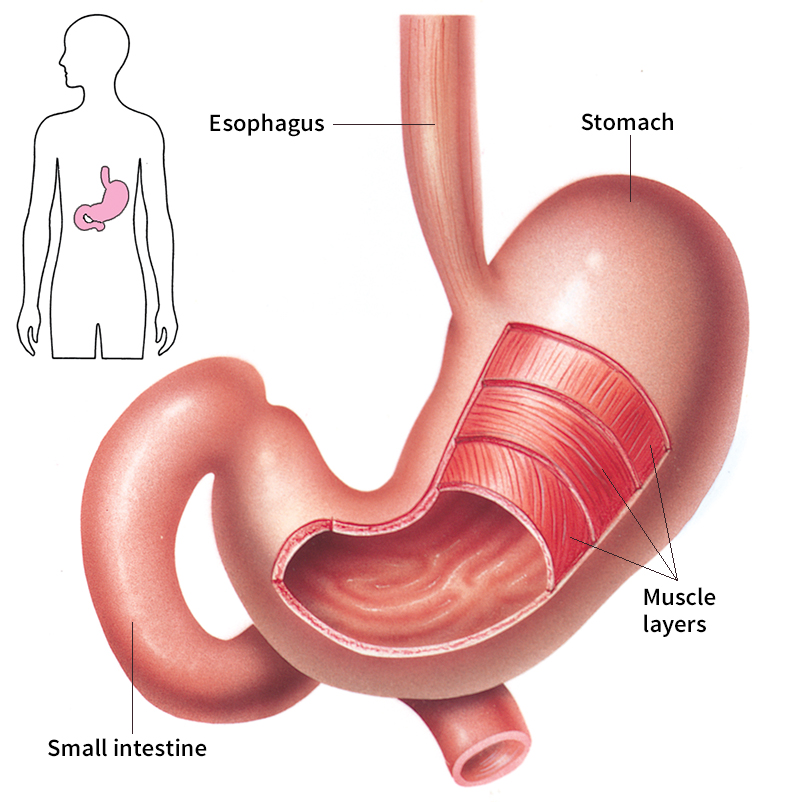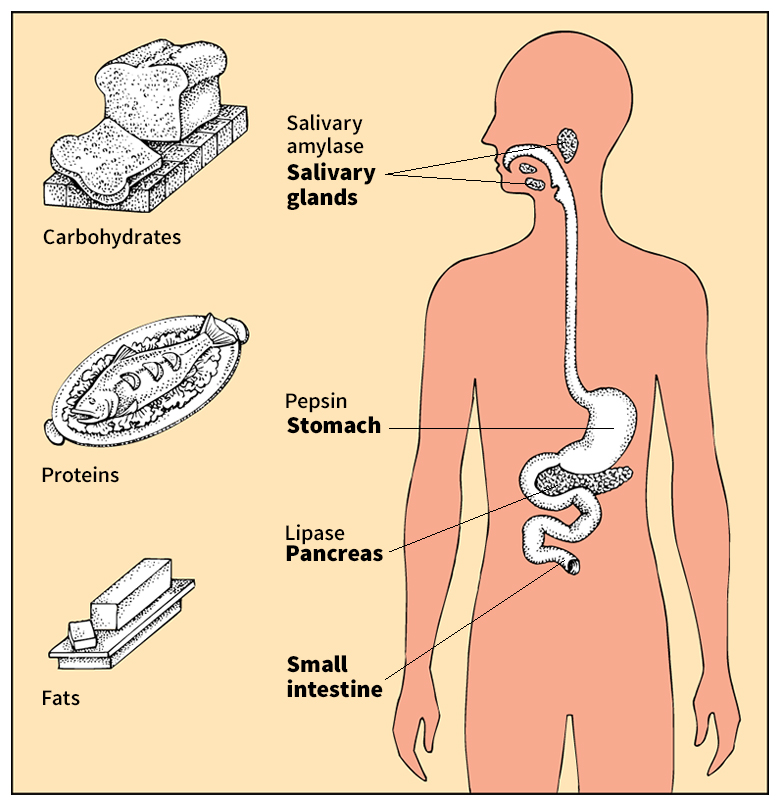Stomach is a muscular organ used to store and digest food. It is an enlarged part of the alimentary canal. The alimentary canal is the tube by which food passes through the body. The stomach lies between the esophagus and the small intestine. In people and most animals, it is a simple baglike organ. In cows, sheep, and other animals that chew their cud, it has four compartments.
A human stomach is shaped much like a J. In most people, it is high in the upper left side of the abdomen. The upper end of the stomach connects with the esophagus. The lower end opens into the duodenum, the beginning of the small intestine. Muscles in the stomach wall enable it to churn and mix its contents.

The stomach’s work.
The stomach serves as a storage place for food, so that a large meal may be eaten at one time. The stomach can fit its shape to the amount of food it holds. The average adult stomach can hold a little over 1 quart (0.95 liter).Food in the stomach is discharged slowly into the duodenum. The stomach also helps digest food.
The arrival of food in the stomach signals cells in the stomach wall to secrete mucus. The mucus lubricates the food. The cells of the stomach wall also secrete a hormone called gastrin. This hormone promotes the secretion of hydrochloric acid and an enzyme called pepsin. These digestive juices begin breaking down proteins in food. The hydrochloric acid also kills many microorganisms (tiny living organisms, such as bacteria) in the food. Other cells give off a substance called intrinsic factor to aid the absorption of vitamin B12.

The stomach muscles churn food and digestive juices into a mass called chyme << kym >> . The muscles then contract and squeeze the chyme toward the pyloric (intestinal) end of the stomach. These contractions, called peristaltic waves, occur about 20 seconds apart. They start at the top of the stomach and move downward. The pyloric sphincter is a ringlike muscle around the duodenal opening. It keeps the chyme in the stomach until it is almost a liquid. The pyloric sphincter then relaxes and lets some chyme enter the duodenum.
The churning action of the stomach tends to begin at usual mealtimes. When people say their stomach is “growling,” they are referring to these peristaltic waves. Sometimes, these movements grow so strong that they squeeze acid gastric juice up into the lower part of the esophagus. Fluids from the stomach can irritate or damage the lining of the esophagus and produce heartburn.
The pyloric sphincter allows water to pass through almost as soon as it enters the stomach. The time that the stomach retains food varies. On the mixed diet most people eat, the stomach empties in three to five hours.
Although the stomach performs many useful functions, it is not absolutely essential for life. Many people lead long lives after their stomachs are either partially or wholly removed because of cancer or ulcers.
Peptic ulcers.
Hydrochloric acid and other digestive juices can eat through the tissues that form the lining of the stomach and adjacent organs. Normally, the body replaces these tissues at about the same rate that they wear away. However, in some cases, the tissues erode faster than the body can replace them. Open sores develop in the affected organ. Such sores, called peptic ulcers, can cause chronic stomach pain.
The two most common kinds of peptic ulcers are gastric ulcers and duodenal ulcers. Gastric ulcers develop in the stomach. They sometimes result from the overuse of aspirin, which can irritate the stomach lining. The consumption of alcoholic beverages also can damage the stomach lining and cause gastric ulcers. Duodenal ulcers form in the duodenum. They usually result from excessive secretion of stomach acid.
Medications to relieve peptic ulcers include histamine H2-receptor antagonists. These drugs reduce secretion of stomach acid. Antacids may also help by neutralizing the acid. Physicians may prescribe antibiotics. Most people with peptic ulcers are infected with Helicobacter pylori, a bacterium. The bacterium can live in the stomach. Scientists believe that this bacterium is associated with the development of ulcers and some stomach cancers. Controlling emotional stress can lessen the chance of developing a duodenal ulcer. Stress stimulates the production of acid, which contributes to ulcer formation.
